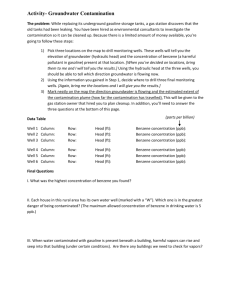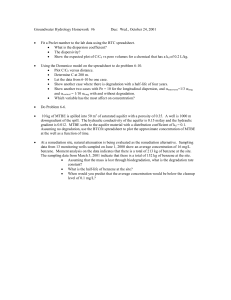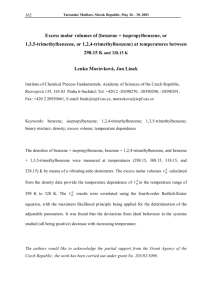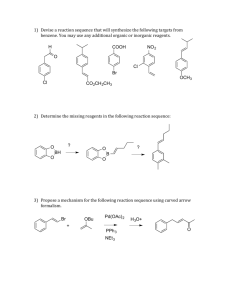gc methods for quantitative determination of benzene in gasoline
advertisement
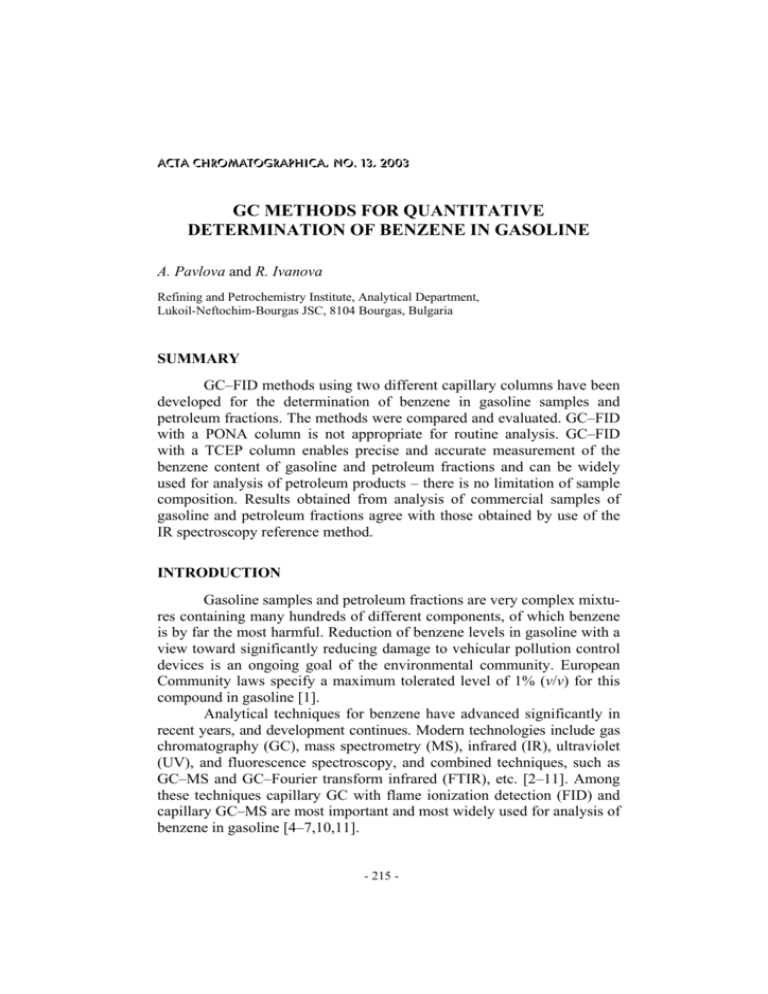
ACTA CHROMATOGRAPHICA, NO. 13, 2003 GC METHODS FOR QUANTITATIVE DETERMINATION OF BENZENE IN GASOLINE A. Pavlova and R. Ivanova Refining and Petrochemistry Institute, Analytical Department, Lukoil-Neftochim-Bourgas JSC, 8104 Bourgas, Bulgaria SUMMARY GC–FID methods using two different capillary columns have been developed for the determination of benzene in gasoline samples and petroleum fractions. The methods were compared and evaluated. GC–FID with a PONA column is not appropriate for routine analysis. GC–FID with a TCEP column enables precise and accurate measurement of the benzene content of gasoline and petroleum fractions and can be widely used for analysis of petroleum products – there is no limitation of sample composition. Results obtained from analysis of commercial samples of gasoline and petroleum fractions agree with those obtained by use of the IR spectroscopy reference method. INTRODUCTION Gasoline samples and petroleum fractions are very complex mixtures containing many hundreds of different components, of which benzene is by far the most harmful. Reduction of benzene levels in gasoline with a view toward significantly reducing damage to vehicular pollution control devices is an ongoing goal of the environmental community. European Community laws specify a maximum tolerated level of 1% (v/v) for this compound in gasoline [1]. Analytical techniques for benzene have advanced significantly in recent years, and development continues. Modern technologies include gas chromatography (GC), mass spectrometry (MS), infrared (IR), ultraviolet (UV), and fluorescence spectroscopy, and combined techniques, such as GC–MS and GC–Fourier transform infrared (FTIR), etc. [2–11]. Among these techniques capillary GC with flame ionization detection (FID) and capillary GC–MS are most important and most widely used for analysis of benzene in gasoline [4–7,10,11]. - 215 - The American Society for Testing and Materials (ASTM) developed a series of test methods specifically for determination of benzene in gasoline: Method D3606 for determination of benzene and toluene in finished motor and aviation gasoline by gas chromatography; Method D4420 for aromatics in finished gasoline by gas chromatography; Method D5580 for determination of benzene, toluene, ethylbenzene, p/m-xylene, o-xylene, C9 and heavier aromatics and total aromatics in finished gasoline by gas chromatography; and Method D5769 for determination of benzene, toluene, and total aromatics in finished gasoline by gas chromatography– mass spectrometry. ASTM standard test methods employ packed columns, capillary columns, or multiple column systems connected with valves, with the chromatograph coupled with thermal conductivity, hydrogen flame ionization, or mass-selective detection. GC–MS methods are seldom used in modern laboratories, because they are labor-intensive, although they are often regarded as reference methods. A brief summary of ASTM, IP, and EN approved methods for benzene analysis is presented in Table I. Each method has its advantages and drawbacks. The need to design a method for the determination of benzene in gasoline was a consequence of two considerations–the ASTM, EN, and IP methods could not be used in our laboratories, because of the particular instrumental requirements, and an easily applicable method was needed for determination of benzene in gasoline and petroleum fractions. This paper gives preliminary results of an investigation of the possibility of using gas chromatography for this purpose. The aim of this work was to demonstrate a new, simple, selective and accurate gas chromatographic method for determination of the benzene content of gasoline and petroleum fractions. The purpose of evaluation of the benzene content was to provide the petrochemical engineer with the information required for process control operation and product quality assurance. EXPERIMENTAL Reagents and Calibration Solutions Benzene, isooctane, and 2-butanone (all 99.5% purity) were obtained from Fluka. Gasoline samples and petroleum fractions, each with different PONA values were obtained from Lukoil Neftochim Bourgas JSC. Five calibration solutions of benzene in isooctane, with and without internal standard, were prepared. The approximate concentrations of benzene were 0.1, 0.5, 1.0, 1.5, and 2.0% (v/v). 2-Butanone was used as internal standard. - 216 - Table I Test methods for determination of benzene in gasoline Method Technique ASTM GC–TCD 3606 ASTM GC–TCD 4420 ASTM GC–FID 5580 ASTM 5769 GC–MS IP 425 GC–FID EN 12177 GC–FID Scope Repeatability 0.1–5%(v/v) for Range finished motor and 0.1–1.5% 0.03(X) + 0.01 aviation gasoline (v/v) 0.1–5%(v/v) for fini0.171 × measured value shed motor gasoline 0.1–5%(v/v) for Range finished motor 0.14–1.79% 0.0265(X0.65) gasoline (v/v) 0.1–4% (v/v) for finished motor gasoRange line; gasoline contai- 0.09–4.0% 0.046(X0.67) ning oxygenated (v/v) blending components Concentration 0.02 0.002 0.05 0.04 0.1 0.06 0.05–6.0% (v/v) 0.2 0.010 0.5 0.019 1.0 0.03 2.0 0.04 5.0 0.08 Range 0.05–0.15% 0.005 (v/v) 0.05–6.0% (v/v) 0.15–1.50% 0.03 unleaded petrol (v/v) 0.05 1.50–6.00% (v/v) Reproducibility 0.13(X) + 0.05 0.408 × measu -red value 0.1229(X0.65) 0.221(X0.67) 0.003 0.005 0.008 0.013 0.025 0.04 0.06 0.11 0.01 0.10 0.25 Chromatographic Systems and Conditions Results were obtained by use of two different gas chromatographs. The first was a Hewlett–Packard 5890 series II model gas chromatograph (GC) equipped with a split/splitless injector, a flame ionization detector, and a 50 m × 0.2 mm i.d. PONA column coated with crosslinked polydimethylsiloxane gum. The injector temperature was 200°C and the detector temperature 250°C. The GC oven temperature was programmed from 35°C at 2° min–1 to 200°C which was held for 10 min. Hydrogen was used as the carrier gas at a flow rate of 1.0 mL min–1; the split ratio was 1:100. - 217 - The second GC system was a Hewlett–Packard model 5890 series II GC with flame ionization detector and a 50 m × 0.25 mm i.d. column coated with a 0.4 µm film of CP-TCEP (Varian). The detector and injector temperatures were 275 and 250°C, respectively, and the oven temperature was maintained at 50°C for 10 min then programmed 10° min–1 to a final temperature of 115 °C which was held for 10 min. Hydrogen was used as carrier gas at a flow rate of 1.0 mL min–1, the split ratio was 1:60. RESULTS AND DISCUSSION PONA Analyses This method was developed to enable determination of the concentration of benzene in gasoline. Fig. 1 depicts the separation of benzene and the other components of gasoline. Benzene was identified by GC–MS. The compound coeluting with benzene, 1-methylcyclopentene, was also identified by GC–MS (Fig. 2). No attempt was made to identify the other components of gasoline. As is apparent from Fig. 1, benzene and 1-methylcyclopentene are not resolved completely to baseline. For this purpose the experimental conditions were varied systematically, using the same capillary column. Isothermal chromatography was performed for 15 min at 35°C and the resolution Rs was calculated by use of the equation: Rs = 2 t R2 − t R1 w R1 + w R2 where tR1 and tR2 are the retention times of 1-methylcyclopentene and benzene and wR1 and wR2 are the widths of the peaks at half height. The resolution R was 1.00. In programmed temperature GC the temperature gradient was changed and the resolution, R, was 1.70. These separation conditions were used for direct determination of benzene in gasoline samples. Quantitative results were obtained from measured areas of the recorded benzene peak, using a response factor obtained from analysis of a blend of known benzene content. The response factor for benzene was measured at a variety of concentrations. The data obtained are given in Table II. The values provided are averages from three analyses. Relative standard deviations from these replicate injections were all small (in the range 0.2–0.4%). The response factor was independent of concentration. Table III shows results obtained from analyses of three blends containing known amounts of benzene in isooctane, performed by a single - 218 - Fig. 1 Partial chromatogram obtained from a gasoline sample on a PONA column operator. Each blend was analyzed five times. The blends contained 0.1, 0.5, and 1.5 (v/v) benzene and were prepared separately immediately before analysis. Thus the results in Table III include variations caused by sample - 219 - Fig. 2 Partial total-ion chromatogram obtained from a gasoline sample, and mass spectra of peaks: 1, methylcyclopentane; 2, benzene preparation and chromatographic analysis. Average values agreed almost exactly with the prepared concentrations. Relative standard deviations were 2.1% or less. - 220 - Table II Response factors of benzene on PONA and on TCEP columns Concn, % (v/v) Response factors of benzene on PONA column Run, N=3 Relative Ave Standard standard response deviation deviation factor (%) 0.5 0.9016 0.8944 0.8989 0.898 0.004 0.4 1.0 0.9389 0.9367 0.9351 0.937 0.002 0.2 1.5 0.9057 0.9041 0.9003 0.903 0.003 0.3 2.0 0.9269 0.9245 0.9231 0.925 0.002 0.2 Response factors of benzene on TCEP column Run, N=5 0.519 0.518 0.528 0.524 0.524 0.525 0.518 0.533 0.525 0.531 0.532 0.540 0.531 0.541 0.540 0.540 0.532 0.555 0.551 0.540 Relative Ave Standard standard response deviation deviation factor (%) 0.523 0.004 0.8 0.526 0.006 1.1 0.537 0.005 0.9 0.544 0.009 1.7 Table III Precision of PONA and TCEP analysis PONA analysis TCEP analysis Stan- Relative Stan- Relative Repea- PrepaRepeata PrepaAverage Reco- dard de- standard Average Reco- dard de- standard tability red (%, bility red (%, v/v) very (%) viation devia(%, v/v) very (%) viation devia(%, v/v) v/v) (%, v/v) (%, v/v) (%, v/v) tion (%) (%, v/v) tion (%) 0.1 0.5 1.5 0.095 0.52 1.52 95 104 101 0.002 0.01 0.01 2.1 1.9 0.6 0.006 0.65 0.03 1.00 0.03 1.80 - 221 - 0.64 1.03 1.78 98 103 99 0.01 0.007 0.01 1.8 0.7 0.7 0.03 0.02 0.04 TCEP Analyses GC analysis is a rapid means of direct measurement of the benzene content of gasoline. Separation of the benzene in gasoline is depicted in Fig. 3, which shows that the proposed internal standard is, indeed, suitable for quantitative analysis. It is apparent that benzene is well separated into an individual peak. Analysis time is of the order of 26 min. Fig. 3 Gas chromatogram obtained from a gasoline sample on a TCEP column Before sample analysis the instrument was calibrated using standard solutions of benzene and 2-butanone in isooctane. Response factors for benzene were calculated relative to the internal standard. Response factors determined for quantitation of benzene by GC–FID are presented in Table II. Calibration was performed by analysis of four concentration levels, each repeated five times. Relative standard deviations for analysis of the calibration mixtures were in the range 0.76–1.65%. The linearity of the method was confirmed by analysis of blends of benzene and 2-butanone in isooctane. Each sample was analyzed five times. Table III shows the results obtained. Average recovery of benzene - 222 - was 100%. Relative standard deviations were 1.8% or less. Precision (repeatability) was determined by use of the standard deviation calculated for five replicate determinations, using the equation: Repeatability = 1.96 2 ⋅ sd 2 Precision was 0.006–0.03%. The procedure developed in our laboratory is rapid, accurate, and highly precise. Recovery, standard deviations for replicate analyses, and repeatability are typical of those obtained for established petroleum GC analyses and satisfactory for routine use of the method for laboratory quality control. Analysis of Real Samples Ten samples of different commercial gasolines and petroleum fractions were analyzed. The petroleum fractions were obtained from two different technology installations. All samples consisted of different amounts of paraffin, olefin, naphthene, and aromatic hydrocarbons. The 1methylcyclopentene content of the samples analyzed was also different, and was in range 0.05–0.30%. Two samples (petroleum fractions from a catalytic cracking process) seemed to contain unusually large amounts of 1-methylcyclopentene – 0.80%. Data from data analysis on the GC-PONA and GC-TCEP columns are summarized in Table IV, which also includes values found by IR spectrometry. It is apparent that values from the proposed Table IV Amounts of benzene determined in real samples Sample Gasoline A92H (15.05.2002) Gasoline A92H (20.05.2002) Gasoline A95H (06.06.2002) Gasoline A95H (18.06.2002) Gasoline A98H (20.06.2002) Gasoline A98H (25.06.2002) Reformat (12.09.2002) Reformat (10.10.2002) Petroleum fraction of catalytic cracking process (05.02.2002) Petroleum fraction of catalytic cracking process (15.03.2002) - 223 - PONA (%, v/v) 0.8 1.1 0.6 0.7 0.8 0.5 1.5 1.6 TCEP (%, v/v) 0.9 0.9 0.5 0.5 0.7 0.6 1.9 1.8 IR (%, v/v) 1.0 1.0 0.5 0.5 0.7 0.6 1.9 1.7 1.2 0.7 0.7 1.3 0.8 0.7 methods and the reference method were comparable for analysis of gasolines and reformat sample. Data obtained by use of the PONA column for GC analysis of petroleum fractions from the catalytic cracking process did not, however, agree with those obtained by GC analysis with the TCEP column or by the IR method. Under the conditions used for PONA analysis the peaks of benzene and 1-methylcyclopentene were not separated sufficiently. CONCLUSION This study was an attempt to explore the potential of equipment in our laboratory for development of methods for determination of benzene in gasoline and petroleum fractions. Application of two capillary columns, conventional PONA and TCEP, enabled the separation of benzene from other compounds in petroleum samples. The success of GC–FID with the PONA column depends on the composition of the gasoline samples and petroleum fractions. It is not appropriate for routine analysis despite the accuracy and the precision established. It was demonstrated that GC–FID with the TCEP column has several advantages compared with analysis on the PONA column, including simplicity of handling, and performance highly precise and accurate measurements of benzene content. The analysis time is 26 min using a simple conventional column and equipment. It was faster and provided information on benzene content, which is the gasoline property regulated. The method will be useful for analysis of other petroleum products containing benzene. REFERENCES [1] Directive 98/70/EC of the European Parliament and of the Council, 13 October, 1998 [2] ASTM D 3606-99. Standard Test Method for Determination of Benzene and Toluene in Finished Motor and Aviation Gasoline by Gas Chromatography, Vol.05.02, 504, 2000 [3] ASTM D 4420-94. Standard Test Method for Aromatics in Finished Gasoline by Gas Chromatography, Vol.05.02, 881, 2000 - 224 - [4] ASTM D 5580-95. Standard Test Method for Determination of Benzene, Toluene, Ethylbenzene, p/m-Xylene, o-Xylene, C9 and Heavier Aromatics and Total Aromatics in Finished Gasoline by Gas Chromatography, Vol.05.03, 620, 2000 [5] ASTM D 5769-98. Standard Test Method for Determination of Benzene, Toluene, and Total Aromatics in Finished Gasoline by Gas Chromatography/Mass Spectrometry, Vol.05.03, 760, 2000 [6] IP 425/96 Determination of Benzene Content of Petrol – Gas Chromatography Method [7] EN 12177:1998 Liquid petroleum products – Unleaded petrol – Determination of benzene content by gas chromatography [8] EN 238:1996E Liquid petroleum products – Petrol – Determination of the benzene content by infrared spectrometry [9] E. Lopez – Anreus, S. Garrigues, and M. de la Guardia, Anal. Chim. Acta, 333, 157 (1996) [10] G.S. Frysinger, R.B. Gaines, E.B. Ledford, J. High. Resol. Chromatogr., 22, 195 (1999) [11] G.S. Frysinger and R.B. Gaines, J. High. Resol. Chromatogr., 22, 251 (1999) - 225 -



